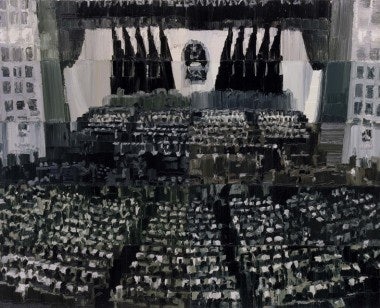Who Will Lead The Way As Output By Blue-Chip Contemporary Chinese Artists Slows?#

Over the past 15 years, as the Chinese contemporary art market went from virtually nonexistent on the global stage to a major world player, blue-chip Chinese artists -- most of whom were raised in the 1960s -- have commanded some of the highest prices among living artists around the world, and in the wake of the global financial crisis prices for their works have steadily ticked upward once again on the strength of China's growing collector base.
But what about China's younger artists? As output of new works by blue-chip artists who gained prominence in the 1990s slows, and their works become more scarce as they're snapped up by domestic collectors, the country's next generation of contemporary artists, the "post-70s generation" born in the 1970s, will inevitably take the stage. Growing up in a China that was quite different than that the one in which their counterparts born one decade before experienced, their work generally takes less of a political bent and, like younger sixth generation filmmakers, looks inward at a China in flux.
"They are a very different new generation of Chinese art, with both mediums and subjects adopted varying from celebrities like Wang Guangyi and Zhang Xiaogang," commented art critic Wang Wei. "They are no longer as enthusiastic at being ironic toward politics as their elder generation were."
Growing up in a fast-developing society, usually with Western impacts in every aspect of life, Chinese artists born in the 1970s tend to reflect the world with their own unique artistic styles and viewpoints.
While capturing a commercialized Chinese society in direct ways such as making installations with coke bottles, Chinese yuan and US dollars, subjects involving personal life affairs including love, marriage, violence and sex are also largely reflected in their works. Sometimes they even turn to reflecting the natural world to search for peace, according to Wang.
The article mentions younger artists like Cao Fei (who actually rose to prominence around the same time as older artists like Yue Minjun or Qi Zhilong), noting that Cao's work eschews the Cultural Revolution iconography and cynicism that defined much of China's 1990s artistic output. It goes on to cover the "Roundtrip: Beijing-New York" exhibition at the Ullens Center for Contemporary Art, which included work by other emerging post-70s generation artists like Li Hui (b. 1977), Li Songsong (b. 1973) and Yang Fudong (b. 1971).
Famous art critic Zhu Qi always speaks highly of young artists born in the 1970s, considering that they will be the new force of Chinese art in the near future as their art breaks the routine of political viewpoints that were adopted by many of their predecessors who are already internationally famous.
He said that while compared with artists born in the 1950s and early 1960s, who usually take memories of the Cultural Revolution (1966-76) as their artistic inspiration, these much younger artists born in the 1970s pay more attention to current social problems and are the leading force of future art trends in China.
"Politic subjects such as the Cultural Revolution used to play a very important role in Chinese contemporary art, but it's time to make some changes," Zhu commented.